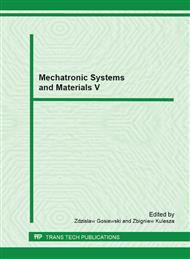p.567
p.575
p.581
p.587
p.593
p.599
p.607
p.615
p.621
Multiscale Modelling Method for Chosen Functionally Graded Material
Abstract:
The paper deals with the numerical and experimental analyses of functionally graded material structures which are represented by a surface layer of the steel sample hardened during the laser treatment process. A functionally graded parameter of the researched structure was assumed as the hardness value experimentally measured with the use of a Vickers hardness test method. The microstructure of the tested layer was also analyzed for the Vickers test verification. Two homogenization methods were used for the purpose of layer substitute properties for numerical calculations. The first one was to divide the FGM domain into a number of layers in the direction of material gradation and then apply a numerical homogenization method within each layer. The resulting material model describes the FGM as a composite of homogeneous layers. The second method was based on the Mori-Tanaka homogenization theory and was carried out with the use of Digimat software, which is the nonlinear multi-scale materials and structures modelling platform. Both methods were compared and showed good correspondence.
Info:
Periodical:
Pages:
593-598
Citation:
Online since:
March 2013
Authors:
Price:
Сopyright:
© 2013 Trans Tech Publications Ltd. All Rights Reserved
Share:
Citation:


